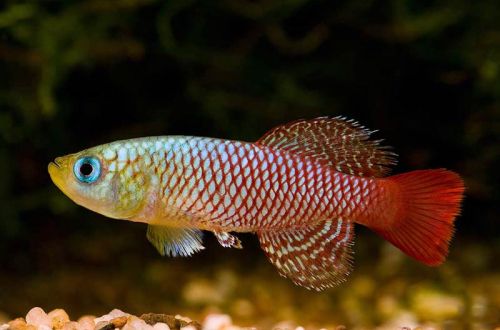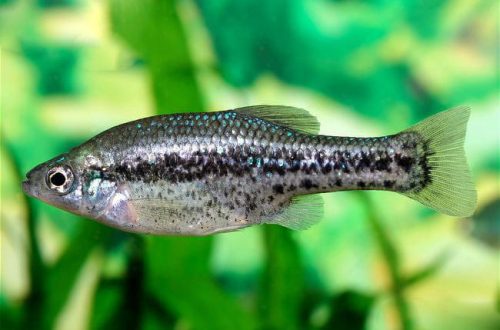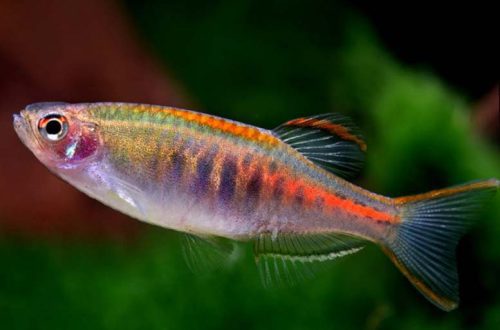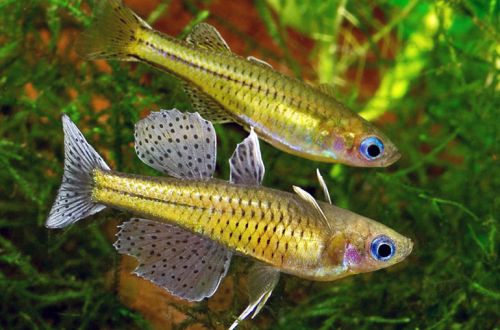
Notobranchius Palmquist
Notobranchius Palmqvista, scientific name Nothobranchius palmqvisti, belongs to the family Nothobranchiidae (Notobranchius or African Rivulins). The fish is named after G. Palmqvist, the sponsor of the expedition to Africa to study the surroundings of Mount Kilimanjaro and Lake Mweru. One of the brightest Killy fish. Its maintenance and breeding is associated with certain difficulties, so it is not recommended for beginner aquarists.

Contents
Habitat
Native to tropical Africa. The habitat extends to the territory of Tanzania and Kenya. Inhabits coastal lowlands, swamps, floodplains and shallow temporary water bodies, from which the fish migrates to permanent ones during drought.
Brief information:
- The volume of the aquarium – from 40 liters.
- Temperature – 18-22°C
- Value pH — 6.0–7.0
- Water hardness – soft (4-10 dGH)
- Substrate type – dark soft
- Lighting – subdued
- Brackish water – no
- Water movement – little or no
- The size of the fish is 5–6 cm.
- Nutrition – any food rich in protein
- Compatibility – in a group with one male and several females
Description
Adult individuals reach a length of 5-6 cm. Males are somewhat larger, have a bright green-blue body color, smoothly turning into red closer to the tail. Depending on the region of origin, yellow specks may be present in the color. Females are smaller and more modestly colored. The main color is gray-pink without variegated flowers.
Food
The basis of the daily diet should be live or frozen food of a suitable size. Some breeders teach dry foods, but they should only be used in addition to the main food.
Maintenance and care, arrangement of the aquarium
The optimal size of the aquarium for 3-4 fish starts from 20-40 liters. The design uses a large number of aquatic plants and soft dark soil. The lighting is subdued. Plants floating on the surface will provide additional shading. Prefers relatively cool water no higher than 22 ° C, so instead of heating the aquarium, it will need to be cooled.
The content of Notobranchius Palmquist includes standard procedures aimed at maintaining a stable hydrochemical composition of water. This is a weekly replacement of part of the water with fresh water, removal of organic waste, cleaning of glass and design elements as necessary, equipment maintenance, etc.
Behavior and Compatibility
Males compete with each other for female attention and territory. In small aquariums, constant skirmishes are inevitable, so it is advisable to maintain a group composition in the amount of one male and several females. Compatible with other species that can live in similar cool conditions.
Breeding / breeding
In nature, reproduction occurs with the approach of the dry season. The fish lay their eggs in a layer of silt at the bottom. The reservoir can dry up completely for several months. All this time, the eggs will be in the depths of the substrate, waiting for the first rains.
A similar cycle must be reproduced at home. Notobranchius Palmquist reaches sexual maturity by 1.5–2 months. Breeding is desirable to produce in a separate aquarium. Boiled and washed peat, or special spawning materials for Killy fish, are used as a substrate. One pair can produce up to hundreds of eggs. The substrate with eggs is removed from the aquarium and left in a wet state for 2.5 months at a temperature of 26–28°C. The eggs mature gradually. If you look at them through a magnifying glass, you can see a clearly defined eye of a fry. By flooding the substrate with fresh water at a temperature of about 18 ° C, the first fry will appear within two hours.
Fish diseases
Hardy and unpretentious fish. Diseases manifest themselves only with a significant deterioration in the conditions of detention. In a balanced ecosystem, health problems usually do not occur. For more information on symptoms and treatments, see the Aquarium Fish Diseases section.





